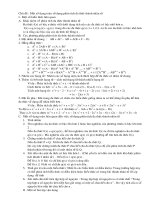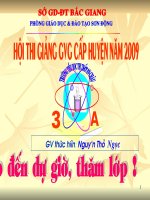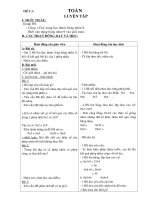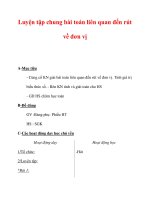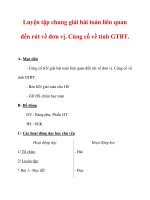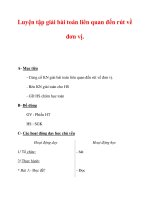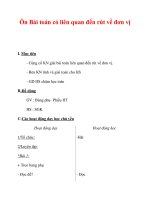Biến Chứng Liên Quan Đến Thuốc Cản Quang Từ Suy Thận Đến Phản Vệ
Bạn đang xem bản rút gọn của tài liệu. Xem và tải ngay bản đầy đủ của tài liệu tại đây (677.43 KB, 27 trang )
Biến chứng liên quan đến thuốc cản quang
Từ suy thận đến phản vệ
TS.BS. Nguyễn Quốc Thái
VIỆN TIM MẠCH VIỆT NAM
Phân loại thuốc cản quang
1. Thuốc cản quang tia X (Radiographic
Contrast Media)
2. Thuốc đối quang từ (MR Contrast Media)
3. Thuốc cản âm (Ultrasound Contrast
Media)
Phân loại thuốc cản quang tia X
Thuốc cản quang
Negative
(Khí, O2, CO2)
Oily
Positive
Iodine compound
Barium
GIT
Powder
Water soluble
Thuốc cản quang Iodine
1. Ionic monomeric contrast media
(highosmolar contrast media, HOCM),
e.g. amidotrizoate, iothalamate,
ioxithalamate
2. Ionic dimeric contrast media (lowosmolar contrast media, LOCM), e.g.
ioxaglate
3. Nonionic monomeric contrast media
(low osmolar contrast media, LOCM),
e.g. iohexol, iopentol, ioxitol, iomeprol,
ioversol, iopromide, iobitridol,
iopamidol
4. Nonionic dimeric contrast media (isoosmolar contrast media, IOCM), e.g.
iotrolan, iodixanol
Contrast Media:
Safety issues and ESUR Guidelines 3rd ed.February 2014.
Biến chứng không liên quan đến thận
Contrast Media:
Safety issues and ESUR Guidelines 3rd ed.February 2014.
Xử trí các biến chứng cấp tính
Nổi mày đay
1. Ngừng tiêm thuốc
2. Không cần điều trị trong phần lớn trường hợp.
3. Cho kháng Histamin H1: uống, tiêm bắp.
Nếu triệu chứng nặng và lan rộng cho thuốc đồng vận alpha (co
động và tĩnh mạch): epinephrin 0.1-0.3 mg tiêm dưới da.
Phù mặt và thanh quản
1. Give O2 6–10 liters/min (via mask).
2. Give alpha agonist (arteriolar and venous constriction):
epinephrine SC or IM (1:1,000) 0.1–0.3 ml (= 0.1–0.3 mg) or,
especially if hypotension evident, epinephrine (1:10,000) slowly
IV –3 ml (= 0.1–0.3 mg).
Repeat as needed up to a maximum of 1 mg.
If not responsive to therapy or if there is obvious acute
laryngeal edema, seek appropriate assistance (e.g.,
cardiopulmonary arrest response team).
Tụt HA và nhịp tim nhanh
1. Legs elevated 60 degree or more (preferred).
2. Monitor: electrocardiogram, pulse oximeter, blood pressure.
3. Give O2 6–10 liters/min (via mask).
4. Rapid intravenous administration of large volumes of Ringer’s
lactate or normal saline.
If poorly responsive: epinephrine (1:10,000) slowly IV 1 ml (= 0.1
mg)
Repeat as needed up to a maximum of 1 mg.If still poorly
responsive seek appropriate assistance (e.g., cardiopulmonary
arrest response team)
Nhịp chậm tụt HA (Vagal Reaction)
1 Secure airway: give O2 6–10 liters/min (via mask)
2. Monitor vital signs.
3. Elevate legs.
4. Secure IV access: rapid administration of Ringer’s lactate or
normal saline.
5. Give atropine 0.6–1 mg IV slowly if patient does not respond
quickly to steps 2–4.
Repeat atropine up to a total dose of 0.04 mg/kg (2–3 mg) in
adult.
6. Ensure complete resolution of hypotension and bradycardia
prior to discharge.
THA nặng
1. Give O2 6–10 liters/min (via mask).
2. Monitor electrocardiogram, pulse oximeter, blood
pressure.
3. Give nitroglycerine 0.4-mg tablet, sublingual (may
repeat × 3); or, topical 2% ointment, apply 1-inch strip.
4. If no response, consider labetalol 20 mg IV, then 20 to
80 mg IV every 10 minutes up to 300 mg. Transfer to
intensive care unit or emergency department.
CO GIẬT
1. Give O2 6–10 liters/min (via mask).
2. Consider diazepam (Valium®) 5 mg IV (or more, as
appropriate) or midazolam (Versed®) 0.5 to 1 mg IV.
3. If longer effect needed, obtain consultation; consider
phenytoin (Dilantin®) infusion — 15–18 mg/kg at 50
mg/min.
4. Careful monitoring of vital signs required, particularly of
pO2because of risk to respiratory depression with
benzodiazepine administration.
Phác đồ xử trí sốc phản vệ
1.
2.
3.
4.
5.
Gọi cho đội cấp cứu
Đảm bảo đường thở
Nâng chân bệnh nhân nếu tụt áp
Thở oxy qua mask (6-10l/ph).
Adrenaline TB (1:1000): 0.5ml(0.5mg) ở người lớn, nhắc lại khi
cần thiết.
Trẻ 6-12 tuổi: TB 0.3ml (0.3mg)
Trẻ< 6 tuổi: TB 0.15ml (0.15mg)
5. Truyền TM NaCl sinh lý, Ringer lactat.
6. Kháng Histamin H1 TM.
Contrast Media:
Safety issues and ESUR Guidelines 3rd ed.February 2014.
Các thuốc và phương tiện cấp cứu cần thiết khi tiến
hành dùng thuốc cản quang
•
•
•
•
•
•
•
•
•
Oxygen
Adrenaline 1:1000
Antihistamine H1
Atropine
B2 agonist (Ventolin, Bricanyl): thuốc xịt họng, khí dung
Nước muối đẳng trương, Ringer Lactat
Thuốc chống co giật (diazepam)
Monitor theo dõi HA, NT
Dụng cụ đè lưỡi, NKQ.
Biến chứng muộn
• DEFINITION: A late adverse reaction to intravascular iodinebased contrast medium is defined as a reaction which occurs
1 h to 1 week after contrast medium injection.
• REACTIONS:
– Skin reactions similar in type to other drug induced
eruptions. Maculopapular rashes, erythema, swelling and
pruritus are most common. Most skin reactions are mild to
moderate and self-limiting.
– A variety of late symptoms (e.g., nausea, vomiting,
headache, musculoskeletal pains, fever) have been
described following contrast medium, but many are not
related to contrast medium.
Biến chứng muộn
RISK FACTORS FOR SKIN REACTIONS:
•Previous late contrast medium reaction.
•Interleukin-2 treatment.
•Use of nonionic dimers.
MANAGEMENT:
Symptomatic and similar to the management of other drug-induced skin
reactions e.g. antihistamines, topical steroids and emollients.
RECOMMENDATIONS:
•Patients who have had a previous contrast medium reaction, or who are on
interleukin-2 treatment should be advised that a late skin reaction is possible
and that they should contact a doctor if they have a problem.
•Patch and delayed reading intradermal tests may be useful to confirm a late skin
reaction to contrast medium and to study cross- reactivity patterns with other
agents.
•To reduce the risk of repeat reaction, use another contrast agent than the agent
precipitating the first reaction. Avoid agents which have shown cross-reactivity
on skin testing.
Phản ứng rất muộn
Definition: An adverse reaction which usually
occurs more than 1 week after contrast medium
injection.
Type of reaction
• IODINE-BASED CONTRAST MEDIA
Thyrotoxicosis
• GADOLINIUM-BASED CONTRAST MEDIA
Nephrogenic systemic fibrosis
BIẾN CHỨNG THẬN
(Renal Adverse Reactions)
Biến chứng thận
• Definition: Contrast induced nephropathy
(CIN) is a condition in which a decrease in
renal function occurs within 3 days of the
intravascular administration of a CM in the
absence of an alternative aetiology. An
increase in serum creatinine by more than
25% or 44 μmol/l (0.5 mg/dl) indicates CIN.
Biến chứng thận do dùng thuốc can quang
Iodine
PATIENT-RELATED
• eGFR less than 60 ml/min/1.73 m2 before intra-arterial administration
• eGFR less than 45 ml/min/1.73 m2 before intravenous administration
• In particular in combination with
• Diabetic nephropathy
• Dehydration
• Congestive heart failure (NYHA grade 3-4) and low LVEF
• Recent myocardial infarction (< 24 h)
• Intra-aortic balloon pump
• Peri-procedural hypotension
• Low haematocrit level
• Age over 70
• Concurrent administration of nephrotoxic drugs
• Known or suspected acute renal failure
Biến chứng thận do dùng thuốc can quang
Iodine
PROCEDURE-RELATED
• Intra-arterial administration of contrast
medium
• High osmolality agents
• Large doses of contrast medium
• Multiple contrast medium administrations
within a few days
Xử trí biến chứng thận do dùng thuốc can quang Iodine
Elective Examination
• Consider an alternative imaging method not using iodinebased contrast media.
• Discuss the need to stop nephrotoxic drugs with the referring
physician.
• Start volume expansion. A suitable protocol is intravenous
normal saline, 1.0-1.5 ml/kg/h, for at least 6 h before and
after contrast medium. An alternative protocol is intravenous
sodium bicarbonate (154 mEq/l in dextrose 5% water), 3
ml/kg/h for 1 h before contrast medium and 1 ml/kg/h for 6 h
after contrast medium.
Phòng ngừa biến chứng thận do dùng
thuốc can quang Iodine
Time of examination
• AT RISK PATIENTS
– Use low or iso-osmolar contrast media.
– Use the lowest dose of contrast medium consistent with a diagnostic
result.
• PATIENTS NOT AT INCREASED RISK
Use the lowest dose of contrast medium consistent with a diagnostic
result.
